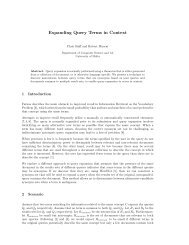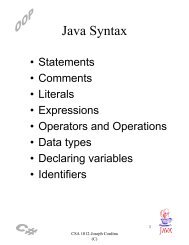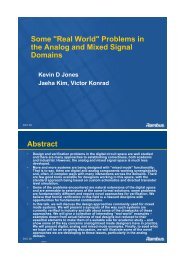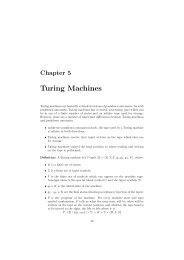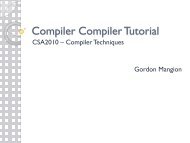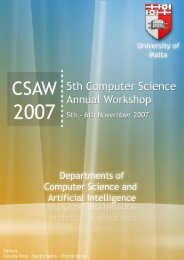Proceedings of CSAW'04 - FTP Directory Listing - University of Malta
Proceedings of CSAW'04 - FTP Directory Listing - University of Malta
Proceedings of CSAW'04 - FTP Directory Listing - University of Malta
You also want an ePaper? Increase the reach of your titles
YUMPU automatically turns print PDFs into web optimized ePapers that Google loves.
Forecasting Using Non-Linear Techniques In Time Series Analysis 23<br />
states (at least the first three phase states) on top <strong>of</strong> each other and observe the variation as time<br />
progresses. In the case <strong>of</strong> non-linear prediction, one is interested in those trajectories which stay in<br />
a bounded area forever. Other trajectories may run away to infinity as time proceeds. One is also<br />
interested in the rate at which they separate away from each other as time progresses<br />
When irregularity is present in the signal we can talk <strong>of</strong> chaos in a deterministic system.<br />
4.1 Phase Space Reconstruction<br />
One plots the phase state <strong>of</strong> the function at different time points. For a single coordinate pair, the<br />
value <strong>of</strong> y will be the value <strong>of</strong> the function at time point n is plotted and the value <strong>of</strong> x will be the<br />
value <strong>of</strong> the function at the previous time point n − 1 the x coordinate. All phase states i.e. the<br />
coordinate pairs s(n), s(n − 1) are evaluated for all n.<br />
The resulting chart will be a plot <strong>of</strong> the state <strong>of</strong> change <strong>of</strong> the system at different time points<br />
ie. the phase state map. If stationarity is present in the process, such a map <strong>of</strong> phase states will<br />
demonstrate this aspect more evidently than a normal time series plot <strong>of</strong> F (t) vs t.<br />
Phase Space Reconstruction Is at the core <strong>of</strong> nonlinear time series analysis. In such reconstructed<br />
spaces, the deterministic features <strong>of</strong> systems can be identified and studied, such as empirical invariant<br />
measures, attractor dimensions, entropies, Lyapunov exponents, equations <strong>of</strong> motion, and<br />
short-term forecasts can be made.<br />
4.2 Elements <strong>of</strong> Phase Space Embedding<br />
[10] The time series is initially a sequence <strong>of</strong> scalar measurements <strong>of</strong> some quantity which depends<br />
on the current state <strong>of</strong> the system taken at multiples <strong>of</strong> a fixed sampling time:<br />
S n = s(x(ndt)) + N n<br />
Some measurement function s and make observations only up to some random fluctuations N n ,<br />
the measurement noise. For a moment we will disregard the effect <strong>of</strong> noise.<br />
A delay reconstruction in m dimensions is then formed by the vectors s n , given as<br />
S n = (s n − (m − 1)v, s n − (m − 2)v, . . . , s n−v , s n )<br />
The lag or delay time is the time difference in number <strong>of</strong> samples v (or in time units vdt) between<br />
adjacent components <strong>of</strong> the delay vectors.<br />
A number <strong>of</strong> embedding theorems are concerned with the question under which circumstances<br />
and to what extent the geometrical object formed by the vectors s n , is equivalent to the original<br />
trajectory x n . Under quite general circumstances if the dimension m <strong>of</strong> the delay coordinate space<br />
is sufficiently large, the attractor formed by s n is equivalent to the attractor in the unknown space<br />
in which the original system is living.<br />
The most important embedding parameter is the product (m x t) — embedding dimensions x delay<br />
time. It is the time span represented by the embedding vector. This can be derived after finding<br />
the two parameters separately.<br />
Finding a good embedding in phase space: [10] In an ideal noise-free data there exists a dimension<br />
m such that the vectors s n are equivalent to phase space vectors Choose too large m — will add<br />
redundancy and degrade performance <strong>of</strong> many algorithms — predictions, Lyaponuv Exponent.<br />
Choose too small an m and the vector will not represent the system and prediction errors will



